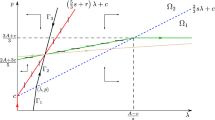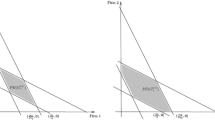Abstract
This paper studies market outcome equivalence of two dynamic production-capital investment games under uncertainty. One is played under complete information, while the other, feedback (FB) game, is played under incomplete information about the opponents’ costs and market demand. The FB game structure may be observed in some newly initiated industries, in which a homogeneous good is exchanged via an auction mechanism. In that case, the FB game setting may predict the complete information equilibrium market outcomes.
Similar content being viewed by others
References
Basar T (1987) Relaxation techniques and asynchronous algorithms for online computation of non-cooperative equilibria. J Econ Dyn Control 11:531–549
Belenkii VZ, Volkonskii VA, Ivankov SA, Pomaranski AB, Shapiro AD (1974) Iterative methods in game theory and programming. Nauka, Moscow
Bertsekas D (1999) Nonlinear programming. Athena Scientific, MA
Forges F (1986) An approach to communication equilibria. Econometrica 54(6):1375–1385
Fudenberg D, Levine D (1993) Steady state learning and Nash equilibrium. Econometrica 61:547–573
Genc TS, Reynolds SS, Sen S (2005) Dynamic oligopolistic games under uncertainty: a stochastic programming approach. J Econ Dyn Control (forthcoming)
Hukuhane N, Kazuo I (1955) Note on non-cooperative convex games. Pac J Math 5:807–815
Kalai E, Lehrer E (1993) Rational learning leads to Nash equilibrium. Econometrica 61(5):1019–1045
Krawczyk JB, Uryasev S (2000) Relaxation algorithms to find Nash equilibria with economic applications. Environ Model Assess 5:63–73
Li S, Basar T (1987) Distributed algorithms of for the computation of non-cooperative equilibria. Automatica 23:523–533
Mertens JF, Sorin S, Zamir S (1994) Repeated games. CORE, discussion paper no. 9420–9422
McKelvey RD, McLennan A (1996) Computation of equilibria in finite games. In: Amman HM, Kendrick DA, Rust J (eds) Handbook of computational economics, vol 1. Elsevier, Amsterdam, pp 87–142
Milgrom P, Roberts J (1991) Adaptive and sophisticated learning in normal form games. Games Econ Behav 3:82–100
Selten R (1991) Anticipatory learning in two person games. In: Selten R (ed) Game equilibrium models 1. Evolution and game dynamics. Springer, Berlin Heidelberg New York, pp 98–154
Uryasev S, Rubinstein R (1994) On relaxation algorithms in computation of non-cooperative equilibria. IEEE Trans Autom Control 39(6)
Von Stengel B (2002) Computing equilibria for two-person games. In: Aumann RJ, Hart S (eds) Handbook of game theory with economics applications, vol 3. Elsevier, Amsterdam, pp 1723–1759
Author information
Authors and Affiliations
Corresponding author
Rights and permissions
About this article
Cite this article
Genc, T.S. A dynamic Cournot–Nash game: a representation of a finitely repeated feedback game. CMS 4, 141–157 (2007). https://doi.org/10.1007/s10287-006-0031-y
Published:
Issue Date:
DOI: https://doi.org/10.1007/s10287-006-0031-y




